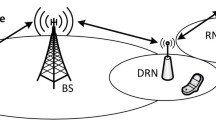Abstract
High frequency (HF) tactical link is one of the most widely used types of long-range telecommunication. Media access control (MAC) protocols play a pivotal role in HF network management by affecting data transmission. STANAG 5066 in its 3rd edition recommends HF wireless token ring protocol (HFWTRP) as a MAC protocol with some features dedicated to HF networks. To deal with temporary link interruption as a natural specification in the HF channel, relay strategy in HFWTRP is proposed to provide better throughput under this situation. Even though one-hop relay is considered in STANAG, multi-hop relay can retain throughput in more link outages when there are mobile nodes or variable environment like weather changes. Based on the algorithm of the relay in STANAG, a loop in multi-hop relay should be found which can be a detrimental effect on the network and can be solved by adding some bits as relay controller in management frame of HFWTRP. This paper presents a proper evaluation on effect of one-hope relay in the quality of service of HF networks. Additionally, two-hope relay in the HFWTRP based on the proposed solution for loop creation are simulated and analysed too. The results obtained by NS3 simulator show that two-hop relay in long duration of link outages like 90% probability of disconnection gives 700 bps more throughput with acceptable mean delay vs one-hop relay.













Similar content being viewed by others
References
Tanenbaum, A. S., & Wetherall, D. J. (2010). Computer networks (5th ed.). Prentice Hall.
Johnson, E. E., Koski, E., Furman, W. N., Jorgenson, M., & Nieto, J. (2012). Third-generation and wideband HF radio communications. Artech House.
Kumar, S., Raghavan, V. S., & Deng, J. (2006). Medium access control protocols for ad hoc wireless networks: A survey. Ad hoc networks, 4(3), 326–358.
Jurdak, R., Lopes, C. V., & Baldi, P. (2004). A survey, classification and comparative analysis of medium access control protocols for ad hoc networks. IEEE Communications Surveys & Tutorials, 6(1), 2–16.
Ergen, M., Lee, D., Sangupta, R., & Varaiya, P. (2004). WTRP-WirelessToken Ring Protocol. IEEE Transactions on Vehicular Technology, 53(6), 1863–1881.
Umaisaroh, U., Hendrantoro, G., et al. (2019). Capacity of 2 × 2 MIMO HF NVIS channels with linearly polarized horizontal antennas. IEEE Wireless Communications Letters, 8(4), 1120–1123.
Witvliet, B. A., & Alsina-Pagès, R. M. (2017). Radio communication via Near Vertical Incidence Skywave propagation: An overview. Telecommunication Systems. https://doi.org/10.1007/s11235-017-0287-2
NSA/1283(2008)C3/5066. (2088). STANAG 5066, 2nd edn. Profile For HF Radio Data Communications.
NS0/0414(2015)C3B/5066. (2015) STANAG 5066 C3B, 3rd edn. Profile for HF radio data communications.
Kurtulus, T. (2010). Improvement and development of high-frequency wireless token-ring protocol. Middle East Technical University.
Johnson, E. E., et al. (2003). Impact of Turnaround Time on Wireless MAC Protocols. https://doi.org/10.1109/MILCOM.2003.1290132
Johnson, E. E., et al. (2004). Performance of the HF token protocol. IEEE Military Communications Conference. https://doi.org/10.1109/MILCOM.2004.1494985
Johnson, E. E., et al. (2003). Robust token management for unreliable networks. IEEE Military Communications Conference. https://doi.org/10.1109/MILCOM.2003.1290136
Johnson, E. E., et al. (2005). Token relay with optimistic joining. IEEE Military Communications Conference. https://doi.org/10.1109/MILCOM.2005.1605998
Cheng, R. G., & Chang, R. T. (2007). Improved wireless token ring protocol (IWTRP) for wireless metropolitan area networks. IEEE Vehicular Technology Conference. https://doi.org/10.1109/VETECS.2007.19
Bi, Y., et al. (2009). A Multi-Channel Token Ring Protocol for QoS Provisioning in Inter-Vehicle Communications. IEEE Transactions on Wireless Communications. https://doi.org/10.1109/TWC.2009.081651
Xiao H., Yunjiang L., et al. (2014). Token-based multiple access technique in High Frequency ground-to-air IP network. In 10th international conference on wireless communications, networking and mobile computing (WiCOM 2014). https://doi.org/10.1049/ic.2014.0140.
Ye, Q., & Zhuang, W. (2017). Token-based adaptive MAC for a two-hop internet-of-things enabled MANET. IEEE Internet of Things Journal, 4(5), 1739–1753.
Shu, R., Shen, C. (2020). Improved token-ring-based MAC scheme for two-hop ad hoc network. In 12th International conference on communication software and networks (ICCSN). https://doi.org/10.1109/ICCSN49894.2020.9139079.
NS-3 documentation. Accessed: November 2020 [Online]. Available: https://www.nsnam.org/documentation/
Funding
The authors have not disclosed any funding.
Author information
Authors and Affiliations
Corresponding author
Ethics declarations
Competing interest
The authors have no actual or potential conflict of interest in relation to this article.
Additional information
Publisher's Note
Springer Nature remains neutral with regard to jurisdictional claims in published maps and institutional affiliations.
Rights and permissions
Springer Nature or its licensor (e.g. a society or other partner) holds exclusive rights to this article under a publishing agreement with the author(s) or other rightsholder(s); author self-archiving of the accepted manuscript version of this article is solely governed by the terms of such publishing agreement and applicable law.
About this article
Cite this article
Gholipoor, P., Madani, M.H. & Poursajadi, S. Performance analysis of multi-hop token relay strategy in HF networks. Telecommun Syst 83, 277–287 (2023). https://doi.org/10.1007/s11235-023-01019-z
Accepted:
Published:
Issue Date:
DOI: https://doi.org/10.1007/s11235-023-01019-z




